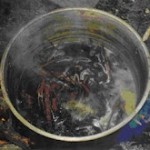Explore Articles Filed Under: Shamanism

Shamans in the Amazon are not unaware of the problems brought about by their encounter with global modernity. On June 1 through 8, 1999, forty of the most prominent traditional healers from seven indigenous peoples convened in Yurayaco, Colombia, to hold an Encuentro de Taitas, a Meeting of Shamans, and to discuss the future of traditional medicine. One result of that meeting was the publication of two documents — a Código de ética de la medicina indígena del piedemonte Amazónico Colombiano, Code of Ethics of Indigenous Medicine of the Foothills of the Colombian Amazon, and the Declaración del Encuentro de Taitas, Declaration of the Meeting of Shamans, often called the Yurayaco Declaration.

Mestizo shamans often mix additional ingredients into the basic ayahuasca drink. In addition to the ayahuasca (Banisteriopsis caapi) and its companion chacruna (Psychotria viridis), chagraponga (Diplopterys cabrerana), or sameruca (Psychotria carthaginensis), some shamans may, at different times, add plants that are believed to modulate the experience of the drink in some way.

Even if you haven’t heard Marshall Arisman’s name, you have seen his work, if not in a gallery then in Time or Esquire or Rolling Stone. It is unmistakable — dark, disturbing, vaguely paranoid. “Hs work rivets the eye and the mind,” writes novelist Paul Theroux. “It is direct and seems unambiguous, but there is inevitably shadow behind it.” Arisman paints and draws … well, creatures, animals, vague hybrids of human and animal, humans as animals — what one reviewer has called “enthralling characters both dangerous and vulnerable, violent and sublime.”

Napo Runa Indians who regularly go to work for the oil companies often have themselves cleansed with tobacco smoke by a shaman when they return to their villages. They are having themselves healed of wage labor; they are being cleansed of capitalism. This is a small act of cultural resistance, affirming the validity of their traditional values over against those of their white employers.

Amazonian mestizos believe that it is possible to lose one’s soul, or part of one’s soul, through more or less natural processes; indeed, soul loss through susto, fright, is a relatively common childhood condition. The sickness category of susto is undoubtedly derived from traditional Hispanic medicine; indigenous Amazonian shamanic traditions of soul loss appear to be too distant geographically and conceptually — for example, among the Wakuénai — to have significantly contributed to the idea. Mestizo shamans also frequently use the term manchari for the same condition, presumably from the Quechua manchay, be afraid.

Byron Metcalf is a drummer, percussionist, and recording engineer who also has a Ph.D. in transpersonal psychology. That’s just the beginning. He has been intensively involved in research on consciousness transformation and spiritual development. He has trained, studied, and worked with shamans and healers from many parts of the world. In particular, he worked with South American shamans from two traditions — don Américo Yábar, an Andean huachumero, and don José Campos, an ayahuasquero currently associated with the Takiwasi Center in Tarapoto.
I have always loved being a stranger. Throughout my life, I have loved to wander in strange places, riding a bus filled with goats and chickens to a small village in the hills where I do not speak the language; sitting in a marketplace, in a small restaurant with tin-topped tables, eating something I had pointed to because I did not know the name, watching the trucks move in and out; riding in the rain in a dugout canoe with an outboard motor going pequepequepeque, waiting to be dropped off on a muddy river bank, somewhere else. That is why I love dreams.
Can there be such a thing as an urban shaman, or is that a contradiction in terms? To think about that question is to think about our idea of the wilderness. The wilderness has been an integral part of the American vision almost from the moment that Europeans stumbled across a huge land whose existence they had never even suspected. The idea of wilderness is now the subject of a deeply political debate couched in postmodernist intellectual terms. Is there really such a thing as wilderness at all, or is wilderness merely a social and historically determined construct – and one that is racist and classist to boot? Is the idea of wilderness a modern idea — even more, a modern American idea — without application to traditional indigenous peoples? What value is there in the wilderness?
A long-standing debate about shamanism concerns the locus of interaction between the shaman and the other-than-human persons with whom the shaman works — between shamans who travel to the land of the spirits, and shamans whose bodies are occupied and possessed by spirits. Often the debate is expressed dichotomously as a matter of power — between the shaman being “the master of spirits” on the one hand, and the shaman being “the instrument of the spirits” on the other. Graham Harvey, a scholar of indigenous religions, puts it this way — that “there is an almost continual conflict between those who think shamans are, by definition, people who control spirits … and those who think shamans are, at least sometimes, controlled by spirits.”
Early anthropologist Martin Gusinde reports the following performance by a shaman in Tierra del Fuego: “He put a few pebbles in the palm of his hand, concentrated on them, and suddenly the pebbles vanished.” Can anyone with even a rudimentary knowledge of sleight-of-hand believe this wasn’t a conjuring trick?

Discussing the article:
Hallucinogens in Africa